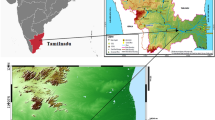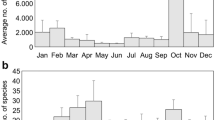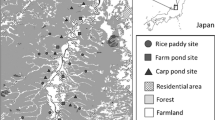Abstract
Rice fields are common throughout the agricultural landscape of Southeast Asia and sustain various bird species. These birds can provide ecosystem services, such as pest control, that improve agricultural yields whilst minimising the use of agrochemicals. This study quantified avian biodiversity in rice production landscapes during three farming stages in Peninsular Malaysia. In Malaysia, rice fields can be an important habitat for migrating birds due to Malaysia’s position on the East-Asian–Australasian Flyway. We determined bird abundance, species richness, and composition in rice field landscapes and compared these during different stages of rice growing. Wetland and terrestrial birds were counted in rice fields using the point-count method. Sixty sampling points were randomly established in three locations, from which 3447 individual birds of 46 species and 26 families were recorded. There was a significant difference in total bird abundance and species richness between the three different stages of rice growing. The growing stage supported greater bird abundance and species richness compared to the pre-harvest and post-harvest stages. Rice-growing provides temporary habitats to different bird species in this managed aquatic landscape. This implies the presence of abundant food, such as small fish and amphibians. The evidence from this study suggests that biodiversity-friendly agricultural practices should be implemented to improve habitat quality for birds in rice production landscapes.

Similar content being viewed by others
References
Acosta M, Mugica L, Blanco D, Lopez-Lanus B, Dias RA, Doodnath LW, Hurtado J (2010) Birds of rice fields in the Americas. Waterbirds 33:105–122
Amano T, Kusumoto Y, Tokuoka Y, Yamada S, Eun-Yong K, Yamamoto S (2008) Spatial and temporal variations in the use of rice-paddy dominated landscapes by birds in Japan. Biol Conserv 141:1704–1716
Azhar B, Lindenmayer DB, Wood J, Fischer J, Manning A, McElhinny C, Zakaria M (2011) The conservation value of oil palm plantation estates, smallholdings and logged peat swamp forest for birds. For Ecol Manag 262:2306–2315
Azhar B, Lindenmayer DB, Wood J, Fischer J, Manning A, McElhinny C, Zakaria M (2013) The influence of agricultural system, stand structural complexity and landscape context on foraging birds in oil palm landscapes. Ibis 155:297–312
Azhar B, Puan CL, Aziz N, Sainuddin M, Adila N, Samsuddin S, Asmah S, Syafiq M, Razak SA, Hafizuddin A, Hawa A, Jamian S (2015) Effects of in situ habitat quality and landscape characteristics in the oil palm agricultural matrix on tropical understory birds, fruit bats and butterflies. Biodivers Conserv 24:3125–3144
Bambaradeniya CNB, Amerasinghe FP (2003) Biodiversity associated with the rice field agroecosystem in Asian countries: a brief review. Working Paper 63. International Water Management Institute, Colombo
Bewick V, Cheek L, Ball J (2004) Statistics review 9: one-way analysis of variance. Crit Care 8:130–136
Bird JA, Pettygrove GS, Eadie JM (2000) The impact of waterfowl foraging on the decomposition of rice straw: mutual benefits for rice growers and waterfowl. J Appl Ecol 37:728–741
Clarke KR, Warwick RM (2001) Change in marine communities: an approach to statistical analysis and interpretation, 2nd edn. PRIMER-E Ltd., Plymouth
Czech HA, Parsons KC (2002) Agricultural wetlands and waterbirds: a review. Waterbirds 25:56–65
Day JH, Colwell MA (1998) Waterbird communities in rice fields subjected to different post-harvest treatments. Colon Waterbirds 21:185–197
Dimalexis A, Pyrovetsi M (1997) Effect of water level fluctuations on wading bird foraging habitat use at an irrigation reservoir, Lake Kerkini, Greece. Colon Waterbirds 20:244–252
Donald PF (2004) Biodiversity impacts of some agricultural commodity production systems. Conserv Biol 18:17–37
Eadie JM, Elphick CS, Reinecke KJ, Miller MR (2008) Wildlife values of North American ricelands. In: Manley SW (ed) Conservation in Ricelands of North America. The Rice Foundation, Skokie, pp 7–90
Elphick CS (2000) Functional equivalency between rice fields and seminatural wetland habitats. Conserv Biol 14:181–191
Elphick CS (2004) Assessing conservation trade-offs: identifying the effects of flooding rice fields for waterbirds on non-target bird species. Biol Conserv 117:105–110
Elphick CS (2008) Landscape effects on waterbird densities in California rice fields: taxonomic differences, scale-dependence, and conservation implications. Waterbirds 31:62–69
Elphick CS (2010) Why study birds in rice fields? Waterbirds 33:1–7
Erichsen AL, Smallwood SK, Commandatore AM, Wilson BW, Fry MD (1996) White-tailed Kite movement and nesting patterns in an agricultural landscape. In: Bird DM, Varland DE, Negro JJ (eds) Raptors in human landscapes: adaptations to built and cultivated environments. Academic Press, London, pp 165–176
Fasola M, Ruiz X (1997) Rice farming and waterbird: integrated management in an artificial landscape. In: Pain DJ, Pienkowski MW (eds) Farming and Birds in Europe. Academic Press, London, pp 210–235
Food and Agriculture Organization (FAO) (2004) FAO Statistical Databases. http://www.fao.org. Accessed 4 Feb 2016
Froneman A, Mangnall MJ, Little RM, Crowe TM (2001) Waterbird assemblages and associated habitat characteristics of farm ponds in the Western Cape, South Africa. Biodivers Conserv 10:251–270
Fujioka M, Lee SD, Kurechi M, Yoshida H (2010) Bird use of rice fields in Korea and Japan. Waterbirds 33:8–29
Hattori A, Mae S (2001) Habitat use and diversity of waterbirds in a coastal lagoon around Lake Biwa, Japan. Ecol Res 16:543–553
Hawa A, Azhar B, Top MM, Zubaid A (2016) Depauperate avifauna in Tropical Peat Swamp Forests following logging and conversion to oil palm agriculture: evidence from mist-netting data. Wetlands 36(5):1–10
Hohman WL, Moore JL, Stark TM, Weisbrich GA, Coon RA (1994) Breeding waterbird use of Louisiana rice fields in relation to planting practices. In: Proceedings of Annual Conference Southeastern Association of Fish and Wildlife Agencies, 48: 31–37
Horgan FG, Stuart AM, Kudavidanage EP (2014) Impact of invasive apple snails on the functioning and services of natural and managed wetlands. Acta Oecologica 54:90–100
Ibáñez C, Curcó A, Riera X, Ripoll I, Sánchez C (2010) Influence on birds of rice field management practices during the growing season: a review and an experiment. Waterbirds 33:167–180
Ismail A, Rahman F, Zulkifli Z (2012) Status, composition and diversity of avifauna in the artificial Putrajaya wetlands and comparison with its two neighboring habitats. Trop Nat Hist 12:137–145
Jeyarajasingam A, Pearson A (2012) A field guide to the birds of Peninsular Malaysia and Singapore. Oxford University Press Inc., New York
Katoh K, Sakai S, Takahashi T (2009) Factors maintaining species diversity in Satoyama, a traditional agricultural landscape of Japan. Biol Conserv 142:1930–1936
Lansdown RV, Rajanathan R (1993) Some aspects of the ecology of Ixobrychus bitterns nesting in Malaysia ricefields. Colon Waterbirds 16:98–101
Ma Z, Cai Y, Li B, Chen J (2010) Managing wetland habitats for waterbirds: an international perspective. Wetlands 30:15–27
MADA (Lembaga Kemajuan Pertanian Muda) (2014). Sejarah penanaman padi di Semenanjung Malaysia. http://ppkh2kepalabatas.wordpress.com/2014/08/20/sejarah-penanaman-padi-di-semenanjung-malaysia/. Accessed 10 Feb 2016
Maeda T (2001) Patterns of bird abundance and habitat use in rice fields of the Kanto Plain, central Japan. Ecol Res 16:569–585
Malaysia Birding (2011) Birding in Malaysia. http://www.malaysiabirding.org/section.php?sid=10&pb=Tier. Accessed 29 Nov 2015
Masero JA, Santiago-Quesada F, Sanchez-Guzman JM, Lopes RJ, Villegas A, Abad-Gomez JM, Encarnacao V, Corbacho C, Moran R (2006) Long lengths of stay, large numbers, and trends of the Black-tailed Godwit Limosa limosa in the rice fields during spring migration. Birds Conserv Int 1:1–13
Ministry of Agriculture (2010) Malaysian plantations. http://www.moa.gov.my/c/document_library/get_file?uuid=d0e%200be21-75aa-4812-969-32a5e68ec7a8andgroupId=10136. Accessed 22 Nov 2015
Mohd Ekhwan T, Er AC, Lee QY, Sharifah Mastura SA, Fuad MJ, Mazlin M, Rahmah E, Mohammad Barzani G, Yusop Z, Norazlina AA, Habibah A, Hamzah J (2013) Paddy production and climate change variation in Selangor, Malaysia. Asian Soc Sci 9:1–8
Nachuha S (2009) Is waterbird distribution within rice paddies of eastern Uganda affected by the different stages of rice growing? Pp. 44-49. In: Harebottle DM, Craig A J FK, Anderson MD, Rakotomanana H, Muchai M (eds). Proceedings of the 12th Pan-African Ornithological Congress, 2008. Cape Town, Animal Demography Unit. (ISBN: 978-0-7992-2361-3)
Nam H, Choi Y, Choi S, Yoo J (2015) Distribution of waterbirds in rice fields and their use of foraging habitats. Waterbirds 38:173–183
Nur Munira A, Nurul Salmi AL, Shahrul Anuar MS, Mohd Abdul Muin MA, Amirrudin A, NurJuliani S (2014a) Diversity and temporal distribution of birds in rice-growing landscape, Northern Peninsular Malaysia. Sains Malaysiana 43:513–520
Nur Munira A, Nurul Salmi AL, Muhd Hakim S (2014b) Use of rice fields by raptors in northern Peninsular Malaysia. Ela J 3:5–14
Nyman JA, Chabreck RH (1995) Fire in coastal marshes: history and recent concerns. In: Proceedings of the Annual Tall Timbers Fire Ecology Conference, 19: 134–141
Paliwal GT, Bhandarkar SV (2014) Observation on the biodiversity conservation of birds in paddy agro ecosystems in different crop stages. Int J Curr Microbiol Appl Sci 3:1161–1165
Parsons KC, Mineau P, Renfrew RB (2010) Effects of pesticide use in rice fields on birds. Waterbirds 33:193–218
Pearlstine EV, Mazzotti FJ, Kelly MH (2006) Relative distribution and abundance of wintering raptors in agricultural and wetland landscapes of South Florida. J Raptor Res 40:81–85
Pierluissi S (2010) Breeding waterbirds in rice fields: a global review. Waterbirds 33:123–132
Post W (1998) Reproduction of least bitterns in a managed wetland. Colon Waterbirds 21:268–273
Robson C (2005) Field Guide to the birds of South-East Asia. New Holland Publisher Ltd, London
Scherr SJ, McNeely JA (2008) Biodiversity conservation and agricultural sustainability: towards a new paradigm of ‘ecoagriculture’landscapes. Philos Trans Royal Soc Lond B 363:477–494
Stafford JD, Kaminski RM, Reinecke KJ (2010) Avian foods, foraging and habitat conservation in world rice fields. Waterbirds 33:133–150
Strum KM, Reiter ME, Hartman CA, Iglecia MN, Kelsey TR, Hickey CM (2013) Winter management of California’s rice fields to maximize waterbird habitat and minimize water use. Agric Ecosyst Environ 179:116–124
Suhaimi O, Abdul Razak H, Ibni Hajar R, Ayob AH, Wan CC, Muhd Radzali M, Aminuddin Y, Abu Hassan D, Mohd Isa O (2006) Baseline information Felcra Seberang Perak rice estate production. MARDI, Selangor
Sulai P, Nurhidayu S, Aziz N, Zakaria M, Barclay H, Azhar B (2015) Effects of water quality in oil palm production landscapes on tropical waterbirds in Peninsular Malaysia. Ecol Res 30:941–949
Takahashi M, Ohkawara K (2007) Breeding behaviour and reproductive success of Grey-headed Lapwing Vanellus cinereus on farmland in central Japan. Ornithol Sci 6:1–9
Townsend SE, Pearlstine EV, Mazzotti FJ, Deren CW (2006) Wading birds, shorebirds, and waterfowl in rice fields within the Everglades agriculture area. Fla Field Nat 34:9–20
Van Groenigen JW, Burns EG, Eadie JM, Horwath WR, Van Kessel C (2003) Effects of foraging waterfowl in winter flooded rice fields on weed stress and residue decomposition. Agr Ecosyst Environ 95:289–296
Wood C, Qiao Y, Li P, Ding P, Lu B, Xi Y (2010) Implications of rice agriculture foe wild birds in China. Waterbirds 33:30–43
Zakaria M, Rajpar MN, Sajap SA (2009) Species diversity and feeding guilds of birds in Paya Indah Wetland Reserve, Peninsular Malaysia. Int J Zool Res 5:86–100
Zedler JB (2003) Wetlands at your service: reducing impacts of agriculture at the watershed scale. Front Ecol Environ 1:65–72
Acknowledgements
We thank the residents of Tanjung Karang, Sekinchan, and Sungai Besar in the state of Selangor for granting us permission to access their farmlands. We are grateful to Adham Ashton-Butt for carefully reading the manuscript and for a number of suggestions on improving the English style.
Funding
We declare that our research was not funded by any organization.
Author information
Authors and Affiliations
Corresponding author
Rights and permissions
About this article
Cite this article
Amira, N., Rinalfi, T. & Azhar, B. Effects of intensive rice production practices on avian biodiversity in Southeast Asian managed wetlands. Wetlands Ecol Manage 26, 865–877 (2018). https://doi.org/10.1007/s11273-018-9614-y
Received:
Accepted:
Published:
Issue Date:
DOI: https://doi.org/10.1007/s11273-018-9614-y




